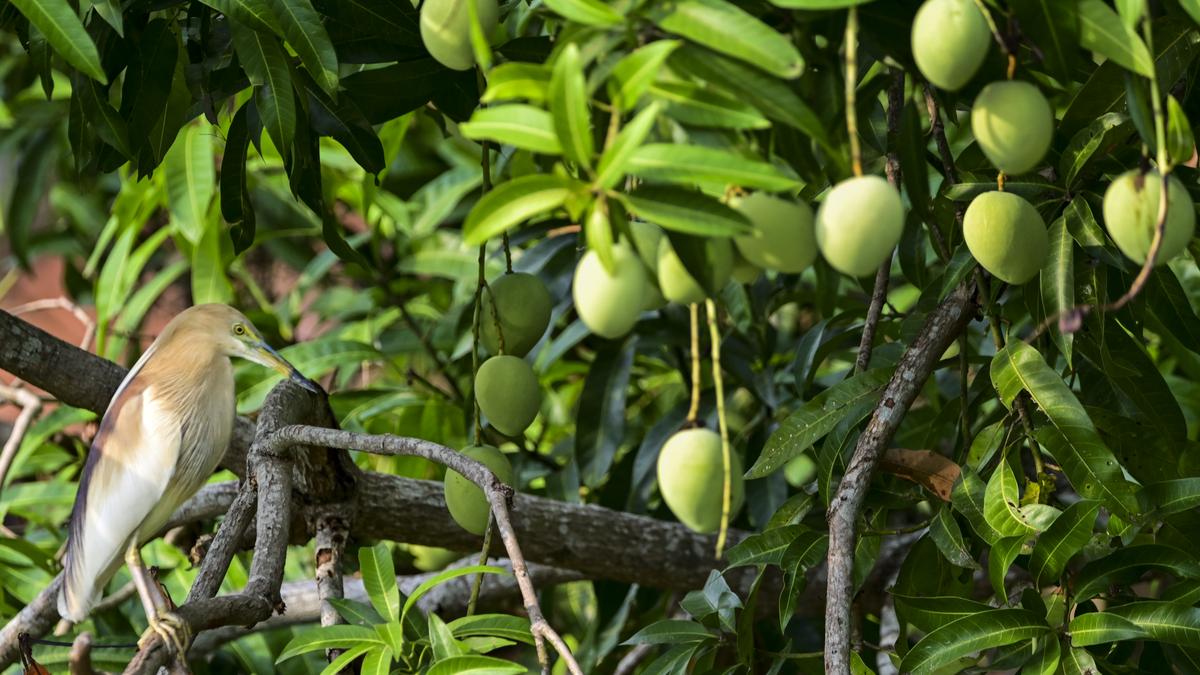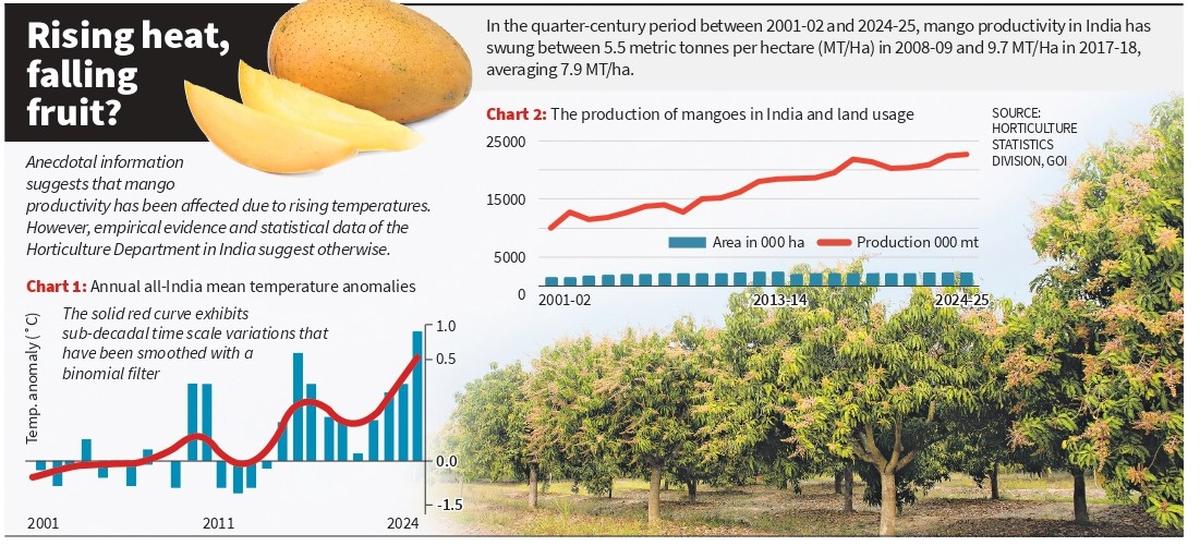- April 30, 2025
High temperatures and mango production | Explained

An egret perches on a mango tree on the outskirts of Kumarakom, Kerala, on April 10.
| Photo Credit: PTI
The story so far:
“There is a drop in mango harvest. Mangoes no longer taste that sweet. Mangoes are expensive. Mangoes are arriving too early in the market. The mango pickle doesn’t last through the year. The mango plant is flowering too early,” these are some of the anecdotal conversations about mangoes in India over the past few years. Is this linked to higher temperatures?
What is the threat?
According to the India Meteorological Department’s (IMD) Annual Climate Survey of 2024, “the country’s annual mean land surface air temperature during the year 2024 was +0.65°C above the 1991-2020 average. Thus, making the year 2024 the warmest year on record since 1901.” IMD data shows that the last 12 years have been warmer than earlier years, defying the statistical norm where there is a see-saw of temperatures with some years cooler than others.
Anecdotal information suggests that mango productivity has been affected due to rising temperatures. Researchers in Egypt who published a paper on ‘Climate change and Mango production’ say that “in the near future, agriculture as a whole and mango production, in particular, will face serious threats from climate change.”
What’s the report from the orchards?
However, empirical evidence and statistical data of the Horticulture Department in India suggest otherwise. In the quarter-century period between 2001-02 and 2024-25, mango productivity in India has swung between 5.5 metric tonnes per hectare (MT/Ha) in 2008-09 and 9.7 MT/Ha in 2017-18, averaging 7.9 MT/ha. In 2024-25, it is expected to be 9.4 MT per hectare. This is higher than the two other leading major producers of mango, which are China (8.74 MT/Ha) and Thailand (8.36 MT/Ha).
According to the Agricultural Market Intelligence Centre at the Professor Jayashankar Telangana State Agricultural University in Hyderabad, the area under mango cultivation has increased. “During 2023-24, mango acreage in India was increased by 2.34% to 24.01 lakh hectares (59.34 lakh acres) with 224.23 lakh tonnes of production (as per the 3rd advance estimates) as compared to 208.72 lakh tonnes of production from 23.46 lakh hectares (57.97 lakh acres) during last year.”

Do heat waves affect trees?
While the impact of higher temperatures on the human body is being studied, the jury is out on the environmental stress experienced by trees and plants. “Higher temperatures cause fruit drop, early maturity, sun scalding, and uneven ripening in mango. In a variety like Alphonso, spongy tissue disorder will be seen,” points out Naga Harshita Devalla, who teaches at the College of Horticulture in Hyderabad.
The mango plant has specific weather requirements from the time buds start appearing by the end of winter. The pollination has to take place before the fruit is set. The budding stage as well as the fruit setting stage is long. Fluctuating weather patterns with intense heavy rain spells and long dry spells are changing the timing of a mango plant’s budding and flowering, says a mango farmer. While rain, hail, or wind can play havoc at any of these stages and affect productivity, the hardiness of mango and higher productivity are being linked to genetic diversity.
Is genetic variation important?
Indian researchers led by Rajdeep Haldar, who published a paper in the International Journal of Advanced Biochemistry Research in March 2024, draw a similar conclusion about mango production and higher temperatures in the region. He linked it to genetic diversity.
“There are multiple reasons to be optimistic about the future of mango production and agriculture. These species have significant adaptability in response to their surroundings. Mangoes possess physiological mechanisms that allow them to adjust and thrive in diverse and demanding environments. The substantial genetic diversity provides several advantages for the transfer of traditional or modern breeding techniques and for determining how to adapt to climate change. The climatic conditions required for the growth and production of mango trees are to some extent compatible with the impacts of global climate change, including drought and high temperatures,” the research paper stated.
Published – April 30, 2025 08:30 am IST







